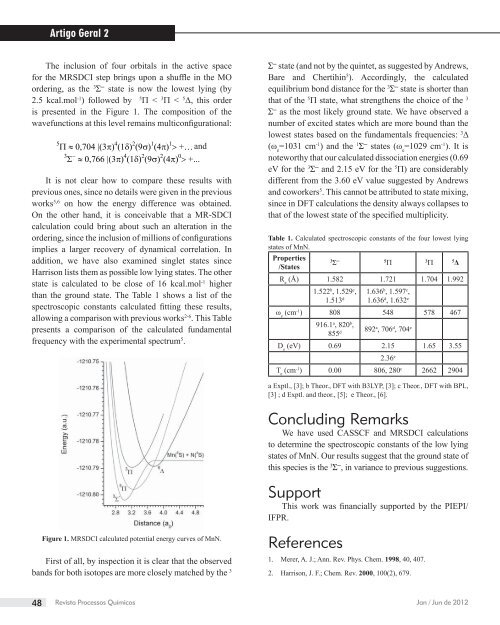Clique aqui para download - senai
Clique aqui para download - senai
Clique aqui para download - senai
You also want an ePaper? Increase the reach of your titles
YUMPU automatically turns print PDFs into web optimized ePapers that Google loves.
The inclusion of four orbitals in the active space<br />
for the MRSDCI step brings upon a shuffl e in the MO<br />
ordering, as the 3 ─ state is now the lowest lying (by<br />
2.5 kcal.mol -1 ) followed by 5 < 3 < 5 Δ, this order<br />
is presented in the Figure 1. The composition of the<br />
wavefunctions at this level remains multiconfi gurational:<br />
and<br />
It is not clear how to compare these results with<br />
previous ones, since no details were given in the previous<br />
works 5,6 on how the energy difference was obtained.<br />
On the other hand, it is conceivable that a MR-SDCI<br />
calculation could bring about such an alteration in the<br />
ordering, since the inclusion of millions of confi gurations<br />
implies a larger recovery of dynamical correlation. In<br />
addition, we have also examined singlet states since<br />
Harrison lists them as possible low lying states. The other<br />
state is calculated to be close of 16 kcal.mol -1 higher<br />
than the ground state. The Table 1 shows a list of the<br />
spectroscopic constants calculated fi tting these results,<br />
allowing a comparison with previous works 2-6 . This Table<br />
presents a comparison of the calculated fundamental<br />
frequency with the experimental spectrum 5 .<br />
Figure 1. MRSDCI calculated potential energy curves of MnN.<br />
First of all, by inspection it is clear that the observed<br />
bands for both isotopes are more closely matched by the 3<br />
48<br />
Artigo Geral 2<br />
─ state (and not by the quintet, as suggested by Andrews,<br />
Bare and Chertihin 5 ). Accordingly, the calculated<br />
equilibrium bond distance for the 3 ─ state is shorter than<br />
that of the 5 state, what strengthens the choice of the 3<br />
─ as the most likely ground state. We have observed a<br />
number of excited states which are more bound than the<br />
lowest states based on the fundamentals frequencies: 3 Δ<br />
(ω e =1031 cm -1 ) and the 1 ─ states (ω e =1029 cm -1 ). It is<br />
noteworthy that our calculated dissociation energies (0.69<br />
eV for the 3 ─ and 2.15 eV for the 5 ) are considerably<br />
different from the 3.60 eV value suggested by Andrews<br />
and coworkers 5 . This cannot be attributed to state mixing,<br />
since in DFT calculations the density always collapses to<br />
that of the lowest state of the specifi ed multiplicity.<br />
Table 1. Calculated spectroscopic constants of the four lowest lying<br />
states of MnN.<br />
Properties<br />
/States<br />
3 ─ 5 3 5Δ R (Å) e 1.582 1.721 1.704 1.992<br />
1.522 b , 1.529 c ,<br />
1.513 d<br />
1.636 b , 1.597 c ,<br />
1.636 d , 1.632 e<br />
ω (cm e -1 ) 808 548 578 467<br />
916.1a , 820b ,<br />
855d 892a , 706d , 704e D (eV) e 0.69 2.15 1.65 3.55<br />
2.36 e<br />
T e (cm -1 ) 0.00 806, 280 c 2662 2904<br />
a Exptl., [3]; b Theor., DFT with B3LYP, [3]; c Theor., DFT with BPL,<br />
[3] ; d Exptl. and theor., [5]; e Theor., [6].<br />
Concluding Remarks<br />
We have used CASSCF and MRSDCI calculations<br />
to determine the spectroscopic constants of the low lying<br />
states of MnN. Our results suggest that the ground state of<br />
this species is the 3 ─ , in variance to previous suggestions.<br />
Support<br />
This work was fi nancially supported by the PIEPI/<br />
IFPR.<br />
References<br />
1. Merer, A. J.; Ann. Rev. Phys. Chem. 1998, 40, 407.<br />
2. Harrison, J. F.; Chem. Rev. 2000, 100(2), 679.<br />
Revista Processos Químicos Jan / Jun de 2012







